
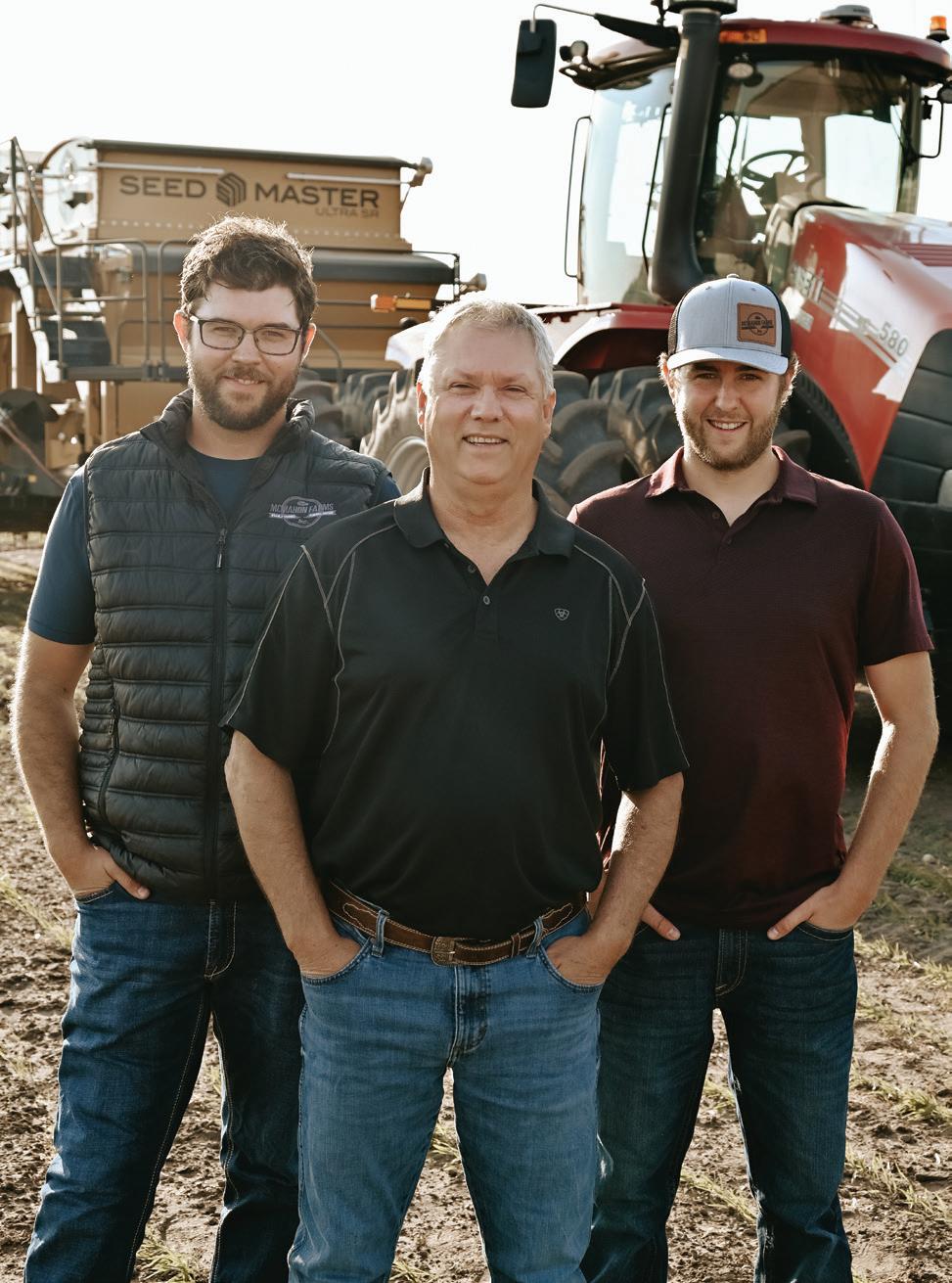



On McMahon Farms, change is rooted in tradition
July 29 – 31, 2025

Publishers
Pat Ottmann & Tim Ottmann
Editor
Lisa Johnston
Design
Cole Ottmann
Regular Contributors
Kevin Hursh
Tammy Jones
Paul Kuntz
Copy Editor
Scott Shiels
Tom Wolf
Nerissa McNaughton
Sales
Pat Ottmann pat@farmingfortomorrow.ca 587-774-7619
Nancy Bielecki nancy@farmingfortomorrow.ca 587-774-7618
Meghan Stuart meghan@farmingfortomorrow.ca 587-774-7617
/farming4tomorrow
/FFTMagazine
/farming-for-tomorrow
/farmingfortomorrow
WWW.FARMINGFORTOMORROW.CA
Farming For Tomorrow is delivered to 79,873 farm and agribusiness addresses every second month. The areas of distribution include Manitoba, Saskatchewan, Alberta and the Peace region of B.C.
The publisher does not assume any responsibility for the content of any advertisement, and all representations of warranties made in such advertisements are those of the advertiser and not of the publisher. No portion of this publication may be reproduced, in all or in part, without the written permission of the publisher. Canadian Publications mail sales product agreement no. 41126516.


–
Kevin Hursh
Angela Lovell
Doug Ferguson

By Kevin Hursh

Producers have many different views and approaches to insurance, whether it’s crop insurance, private hail insurance or AgriStability.
The Livestock Price Insurance program is a prime example. The deadline for cow-calf producers to buy Livestock Price Insurance for the fall calf run was the middle of June. Record high floor prices could be locked in.
Floor prices and premiums fluctuated, but at the close of the program in Alberta, a price of over $2,800 for a 600-pound steer could be locked in for the beginning of November. The premium for that insurance was $56 a head.
If you wanted a less expensive option, a floor price of nearly $2,700 a head could be locked in for a premium of $26 a head. That’s a premium rate of less than one per cent.
The floor prices were higher than the best returns most producers have ever received. As well, the insurance was relatively cheap and yet many cow-calf producers paid little attention. Cattle prices are high and forecast to remain high, so why buy insurance?
Actually, it was the best time to buy insurance. Yes, prices are forecast to remain high, but what if some unforeseen political event closes the border or what if there’s a foreign animal disease outbreak? Remember what the BSE case in Canada did to cattle prices back in 2003?
You don’t buy insurance on your farm shop or house hoping to collect. If you buy Livestock Price Insurance and don’t collect, it’s good news. It means prices are even better than the insurance.
Livestock Price Insurance is offered by and administered by government, but unlike many other programs, it isn’t subsidized. That’s unfortunate. LPI should be cost shared by government, just like crop insurance programs.
Concerning crop insurance, over a farming career you are likely to receive more money in crop loss payments than you pay in premiums. With governments covering the administration costs and 60 per cent of the premium, the
It isn’t the premium cost of AgriStability that keeps producers from joining; it’s the complexity and expense of doing the annual submission.
odds are stacked in favour of producers.
That’s also true for AgriStability. In my view, it’s unfortunate that so many producers never joined, or joined and subsequently opted out. If agriculture gets in a serious bind, the easiest way for government to provide extra support is to enhance AgriStability payment and support triggers. If you aren’t in the program, you could miss out.
It isn’t the premium cost of AgriStability that keeps producers from joining; it’s the complexity and expense of doing the annual submission.
Many producers who hate AgriStability would never go without private hail insurance coverage on their crops. Hail insurance is simple and straightforward. While private hail insurance companies provide a valuable service, they are in business to make money. Premiums are set at levels that cover all of their costs while also providing a company profit.
The same goes for insurance on your house, shop and farm equipment. Of course, you need to be adequately insured, but know that the long-term odds are stacked against you regarding a return on money invested.
Even without government cost sharing of premiums, Livestock Price Insurance for the fall calf run seemed like a no-brainer this year. If something unforeseen causes calf prices to crash, it will be a bitter pill for those who didn’t take advantage of the program.
Understanding and analyzing all the various insurance options and how they might meet your needs is time well spent.

AgExpert gives you a bird’s eye view of your data, helping you connect every dot on your farm. It’s your connection to confident, data-driven choices on everything from the field to the books. Solid, simple farm management, made for the way you work.


Farming and ranching are part of an incredibly diverse and demanding industry filled with some of the most hardworking and resilient people. At AFSC, we want to celebrate the agriculture industry by sharing stories of the drive, dedication and determination of Alberta producers.
SHOW US YOUR BOOTS. TELL US YOUR STORY.
AFSC.ca/boots

BY ANGELA LOVELL
PHOTOGRAPHY BY COLDSTREAM PHOTOGRAPHY & FILM
On McMahon Farms near Galahad, Alberta, the transition to the sixth generation is well underway. Stuart and Joanne McMahon are determined to give their sons the tools and experience they will need to grow the operation and keep it sustainable long into the future.
That means a willingness to do things differently than when Stuart McMahon took over from his father 25 years ago. He was the oldest of four children – the only one who stayed to farm – and his dad wanted things done his way.
“I learned to do things the way he liked them to be done, and we arrived at our own harmony,” McMahon says. But by his late 20s, he realized he wasn’t as prepared to manage the farm as he wanted to be. “It dawned on me that I didn’t have much experience in how to make big decisions, like could we afford to buy a piece of land or a new tractor? Should we be trading our drills and trying to seed a different way? Or trying different kinds of crops?”
That experience meant that by the time his sons committed to a future on the farm, he wanted to ensure they would be better prepared. From a young age, McMahon involved them in discussions and decisions so they could get a feel for what managing the farm was like. He even encouraged them to take leadership positions in their 4-H club because he wanted them to build confidence, learn responsibility and make thoughtful decisions.
Growth is a necessity
Cole, the oldest of the McMahon boys, is 28 and after completing an agribusiness degree at the University of Saskatchewan, he worked in ag lending before returning to

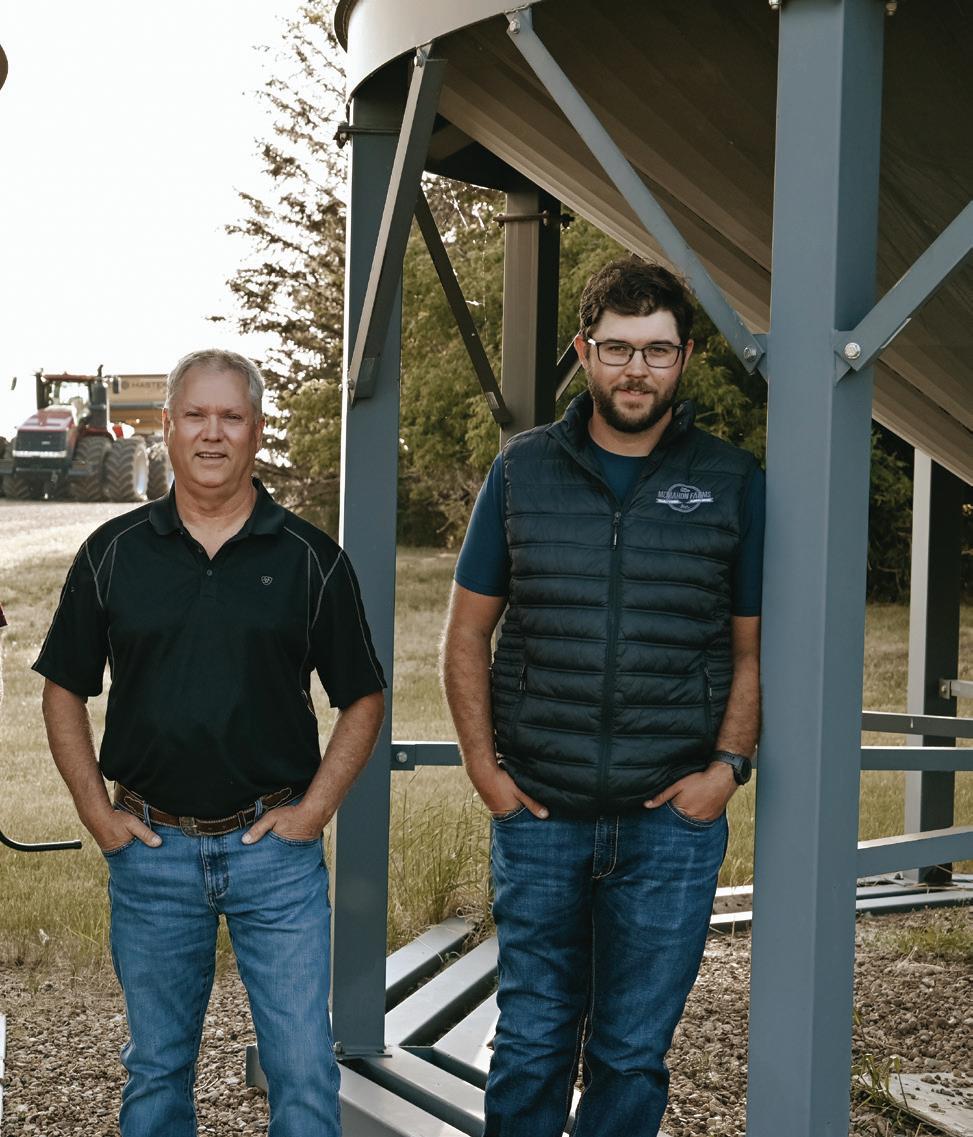


farm full time several years ago. Tucker, 25, completed two diplomas in ag management for production management and agri-commerce at Olds College and currently works as a grain buyer and facility manager for a local railroad, while farming as much as he can. He also hopes to return to the farm full time in the future. The third son, Layton, is living and working off the farm and still deciding on his direction.
The farm has grown considerably over the years, almost doubling in size with each generation, although McMahon has accelerated that growth even further, increasing from around 1,600 acres when he started farming to over 5,000 today, and much of that expansion came in the last eight to 10 years as the McMahon boys came on board.
“It used to be you needed between 2,000 to 2,500 acres for one family to live off of and that’s probably on the short side now,” he says, adding it’s not easy to expand in the area because of competition from larger farms and high land prices.
The McMahons have never been afraid to try new ways of doing things. Back in the ’80s, McMahon’s dad was an early adopter of no till during a period of dry conditions, a depressed economy and high interest rates.
“There was lots of invention going on all over Canada for how to conserve moisture and that’s when no-till farming started, out of necessity, in trying to save a little bit more moisture by not working the ground,” McMahon says. “From there came advances in equipment to make it possible to no-till farm better, and herbicide options to keep fields clean. Those were game-changers. Today, we have screens all over the place in our tractors, trying to get more information and figure out a way of making it useful.”
McMahon has always been more interested in the agronomy side of the farm than the business and marketing, and is happy to leave that to Cole. “I am fortunate that’s the stuff that Cole loves,” he says. “Business management is the most important thing on the farm right now.”
Meanwhile, he’s coaching Tucker on the agronomy side. “Tucker was able to help out more this spring and it was a good opportunity for us, although I struggled to keep my mouth shut and let the boys make the decisions, but it worked awesome,” he says.
The family is just beginning to make the transition more formal by bringing Cole and Tucker into the company as shareholders while working to keep the arrangement as business-like as possible.

“We have started having family business meetings, which felt strange at first to be around the table with the people you sit around the table with every day, but we’re getting better at it,” McMahon says. “We are using a good lawyer and accountant to lay the groundwork for what the company is going to look like once the boys are in it. We are trying to set it up so that there are responsibilities set out and accountability for those.”
If you ask the McMahons about the future of the farm, you will likely get three different answers reflecting where they are at in their lives and farming careers. Cole has ambitions to continue expanding the farm, and Tucker wants to be able to farm full time, which means the farm has to grow to accommodate their future goals. Dad, on the other hand, is more concerned with quality of life.
“I love what we do, I love what we’ve been able to do, I love where we get to live and I put a higher priority on that than how many acres we farm,” he says. But he knows there are always trade-offs and the farm has to get bigger. “We grew by 1,400 acres last year and by 900 a few years before, but I just want us to have a comfortable living and farm the best way we can.”
Despite the fact that he knows farms have to grow in today’s world to be sustainable for future generations, he also sees that as a challenge for agriculture in the future.
“Where it used to be there was one or two families on every section, now there’s one family on 12 sections and soon there’s going to be one family on 20 sections. The Prairies will still be farmed but with half as many people,” he says. “Consequently, those people will be living in a world where they don’t have as much say, and sooner or later regulations
“I love what we do, I love what we’ve been able to do, I love where we get to live and I put a higher priority on that than how many acres we farm.”
- Stuart McMahon
and public perceptions are going to set the ground rules for how you get to farm. People wanting to have their finger in the regulation of an industry they know absolutely nothing about is going to be the biggest problem we have.”
That said, he’s still optimistic about the future and sees opportunities to grow different crops while adopting ever more technology. The next generation, he knows, isn’t scared to take risks and they have the ability and the drive to make a success of farming.
“On the technology side, information management is a monumental task. And I think product tracking is going to be huge, so consumers or buyers can see who grew what, how they grew it and what management went into it so that they can buy what they want, how they want it done,” he says. “Although where we are, it’s almost all grain farming and we’re just growing bulk commodities, so things haven’t changed a whole lot in the last 50 years, and I don’t know how much they’re going to change in the next 50. It’s still dirt, seeds, plants and rain.”


July 29-31 2025


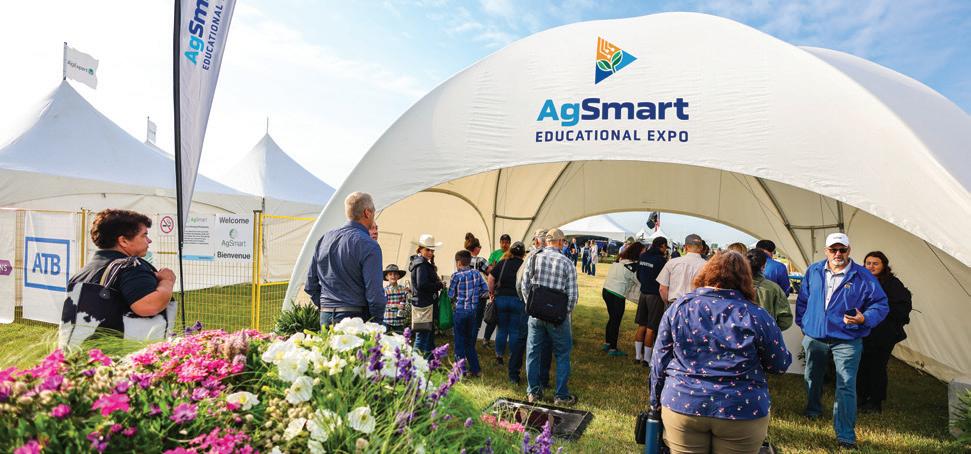
AgSmart presented by Agri-trade is designed to combine traditional farming practices with new, emerging and innovative learning and technology that will result in greater productivity, efficiencies and forward focused solutions. Come and meet industry experts as they share hot topics, engage with interactive conversations and be inspired by success stories from vendors that deliver unique opportunities. Join us to discuss carbon footprint, risk management, solar energy, soil health, precision agtech, rotational grazing and so much more! Most especially, we are thrilled to share an Alberta celebrity and keynote speaker James Lawrence, The Iron Cowboy who will inspire, mentor and motivate us all! There will be a strong group of trade show and educational masters present to deliver a high-quality agriculture insight and experience for both crop and livestock producers.
In 2025, we are proud to showcase AgSmart in the heart of Olds College Campus where we can enjoy the amenities, pristine campus and elevated learning spaces. We will also enjoy the opportunity to gather and collaborate in the field at AgSmart Crop Science Day as we collectively pursue hands on innovation and excellence in the agriculture and smart technology sectors.
Tracy Gardner

Known as The Iron Cowboy for the hat he wears so his five kids can spot him during races, James Lawrence is an ultra-endurance athlete who has redefined the limits of human performance. In 2012, he completed 30 Ironman triathlons in a year—a feat no one had come close to. Then in 2015, he finished 50 Ironmans in 50 days across 50 states, raising funds to fight childhood obesity. In 2021, he went even further, completing 100 Ironman-distance triathlons in 100 consecutive days to support anti–sex trafficking efforts. Once a mortgage broker who struggled to finish a 4-mile fun run, James rose from rock bottom to become a world-renowned speaker and best-selling author, inspiring millions to push beyond the impossible.





MNP Partner, Director of Agriculture Risk Management Resources
Based in Kelowna, AJ Gill brings a lifelong passion for farming and deep roots in agriculture, having grown up on a farm after moving to Canada from India in 1988. With nearly 20 years in federal and provincial government roles, he helped transfer the AgriStability program to B.C. and advised on national agriculture policy. Before joining MNP, he served as General Manager of the B.C. Ministry of Agriculture.
Chief Executive Officer of AdvancedAg
Joshua Day Chief is the CEO of AdvancedAg (AAG), leading the company since 2013 with a focus on redefining biological technology in agriculture. Through research, collaboration, and a commitment to sustainability, he has positioned AAG as a global leader in soil and water remediation. A visionary and environmental advocate, Joshua champions a future where innovation and sustainable agriculture go hand in hand.
Managing Director of AbacusBio Canada
John Crowley is Managing Director of AbacusBio Canada, bringing over 15 years of expertise in genetics, agri-business, and data analytics. With a PhD in statistical genetics, he’s led major initiatives in genomic selection and breeding strategy. John is a collaborative leader focused on advancing sustainable, data-driven agriculture.
Farm Coach
Reg Shandro blends expertise in agriculture, finance, and family mediation to help farm families thrive. With a proven approach to succession, business planning, and conflict resolution, he’s delivered over 150 presentations across North America. A natural storyteller, Reg makes complex topics approachable—driven by a genuine passion for supporting farm families.
AFSC Product Coordinator
Leslie McEachern is a Product Coordinator at AFSC, supporting the development of sustainability-focused risk management tools. She and her husband run a livestockfocused mixed farm in Barrhead and Lac Ste. Anne Counties. Passionate about soil health, Leslie also serves on the Farming Forward board and is helping lead a pilot project exploring how Soil Organic Matter can reduce risk and improve environmental outcomes.
AgSmart 2025
For the most up-to-date schedule, please visit our website: www.agsmartolds.ca
Speaker Company
James Lawrence
AJ Gill MNP
John Crowley AbacusBio Canada
Evan Buie Global Affairs Commission
Ryan Copithorne Cows In Control
Topic
The Iron Cowboy
Managing Farming Risks with Confidence
What is a Carbon Footprint?
Bridging Borders: Seeding Canadian AgTech Success in Mexico
From Innovation to Profits in Your Ag Business
Scott Meers Mayland Consulting Good Bugs, Bad Bugs?
Leighton Kolk Kolk Farms Ltd.
Joel Smit Manulilft
How Can I Embrace Technology?
How Can I Embrace Technology? FCC
Dr. Desiree Gellatly OCCI
Dr. Yaogeng Lei OCCI
Dr. Shabeg Briar OCCI
Dr. Felippe Karp OCCI
Herman Simons OCCI
Dr. Sementon Amosu OCCI
TBD
Using FerAppease to Improve Performance in Weaned Beef Heifers
Novel Enzyme Supplement for Backgrounding Beef Cattle Production
Plant-Parasitic Nematodes: Should Prairie Farmers be Worried?
Profitable Crops: How On-Farm Precision Experimentation Leverages Precision Ag Tech
Profitable Crops: How On-Farm Precision Experimentation Leverages Precision Ag Tech
Is Farming & Solar Energy Production Compatible? The Promise of Agri-Voltaics in Alberta
Russell Shuttleworth AFSC Bytes, Bushels, and Backstops
Manglai & Leslie McEachern AFSC
Speaker Company
Xavier HerbertCouturier Foresight CAC
Joshua Day Chief AdvancedAg
Scott Dickson
Reg Shandro
Tim Wray
Kristine Flaim AB Living Labs
Cheyenne Lambley Gallagher
Testing the Link Between Soils and Risk on Alberta Farms
Topic
Wanna Win Best Farmer Award?
Wanna Win Best Farmer Award?
How can the Next Generation Afford Anything?
How can the Next Generation Afford Anything?
How to Keep Cattle Rotated & Fenced.
How to Keep Cattle Rotated & Fenced.
How to Keep Cattle Rotated & Fenced.
Cale Place Verified Beef Production Adding Value to my Livestock Herd
Kajal Latimer Canadian Angus Assoc. Adding Value to my Livestock Herd
Dr. Karthi Narayanan Croplands Solutions
Michael Launer Johnston’s Regenerative
Building Soil Health to Achieve Farm Wealth
Building Soil Health to Achieve Farm Wealth






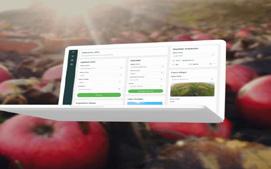


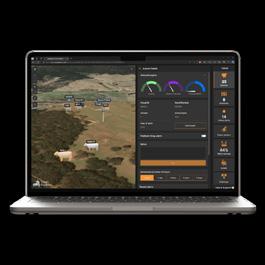


Scan to view the detailed Exhibitor Maps:






As stewards of the land, Albertans know the value of using every resource wisely. We’re proud to support communities across the province by giving new life to old materials.
Together, we’ve already kept 259,762 tonnes of electronics, 36.5 million litres of paint, 149.5 million tires, and 2.3 billion litres of used oil out of land lls.
Now, with Extended Producer Responsibility (EPR), an expanded electronics recycling program, and new initiatives exploring the recycling of solar PV, EV batteries, and wind turbine electrical components, Alberta is taking bold steps to reduce waste, protect valuable resources, and keep our land clean and productive for future generations.
Learn more about what you can recycle at albertarecycling.ca




Discover how our grant-eligible electric fencing systems have protected hundreds of thousands of acres across Canada. Stop by our booth for a live demo and learn how to secure available funding.



Are you passionate about the profitability and sustainability of your operations?
Are you curious about how you can leverage emerging technologies?
If you said Yes, then you may be the perfect fit for our new program!



Direct On-Farm Agtech Validation: Gain insights and ROI in your operations, at no cost. Be paid for your participation and expertise!
Collaboration in Innovation: Work with experts from our Smart Farm network and cutting-edge Canadian agtech providers to address your needs.
Farm Data Integration: View your farm/ranch data in one place, even paper records! Your data remains entirely your property.

&

Agri-Food






Do you offer cutting-edge robotics, AI or data-based decision-making in Ag?
Are you ready to accelerate development with your ideal customers?
If you said Yes, then you may be the perfect fit for our new program!
Direct On-Farm Agtech Validation: Train your models and confirm ROI under real-world conditions.
Collaboration in Innovation: Work with innovative producers and experts from our Smart Farm network to refine your innovation.
Financial Support: Offset the costs of on-farm/on-ranch testing with funding from CAAIN.







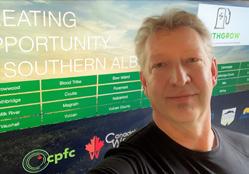







For the most up-to-date schedule, please visit our website: www.agsmartolds.ca

Presented by:

DAY 1 ~ Tuesday, July 29th
8:30 am Doors Open Werklund Centre
8:30 am Olds College Smart Farm Tour FIELD
8:30 am Field Demonstrations FIELD
10:00 am KEYNOTE SPEAKER ~ The Iron Cowboy, James Lawrence Werklund Centre 316
11:00 am Coffee Break at Werklund Werklund Centre
11:30 am Managing Farming Risks with Confidence ~ Featuring AJ Gill, MNP Werklund Centre 316
11:30 am What is a Carbon Footprint? Featuring John Crowley Werklund Centre 301
11:30 am FCC’s Featured Speaker Werklund Centre 304
11:30 am Novel Enzyme Supplement for Backgrounding Beef Cattle Production. ~ Featuring Dr. Yaogeng Lei, OCCI Werklund Centre 312
11:30 am Bridging Borders: Seeding Canadian Agtech Success in Mexico. ~ Featuring Commissioner Trade Service Werklund Centre 305
11:30 am Outstanding Young Farmers Presentations Werklund Centre 302
12:30 pm Lunch at the AFSC Crossing Restaurant & Pub Alumni Center
1:00 pm The Dish, Do More Ag, and a Screening of Deep Rooted ~ Presented by AFSC The Hive
1:30 pm From Innovation to Profits in your Ag Business ~ Featuring Ryan Copithorne Werklund Centre 316
1:30 pm Field Demonstrations FIELD
2:15 pm Plant Parasitic Nematodes: Should Farmers be Worried? ~ Featuring Dr. Shabeg Briar, OCCI Werklund Centre 316
2:15 pm Adding Value to my Livestock Herd! ~ Featuring Cale Place, Verified Beef Production & Kajal Latimer, Canadian Angus Association Werklund Centre 301/302
2:15 pm Bytes, Bushels & Backstops! ~ Featuring Russell Shuttleworth, AFSC Werklund Centre 304/305
3:00 pm Coffee Break at the Tradeshow Alumni Center
3:30 pm Field Demonstrations FIELD
3:30 pm Olds College Smart Farm Tour Alumni Center
DAY 2 ~ Wednesday, July 30th, 2025
8:30 am Doors Open Werklund Centre
8:30 am Olds College Smart Farm Tour FIELD
8:30 am Field Demonstrations FIELD
10:00 am How can I Embrace Technology? ~ Leighton Kolk, Kolk Farms Ltd. & Joel Smit, Manulift Werklund Centre 316
10:45 am Coffee Break at Werklund Werklund Centre
11:30 am Good Bugs & Bad Bugs? ~ Featuring Scott Meers Werklund Centre 304
11:30 am How to Keep Cattle Rotated & Fenced ~ Featuring Cheyenne Lambley, Gallagher; Kristine Flaim, Living Labs; Tim Wray Werklund Centre 301/302
11:30 am Profitable Crops: How Precision Experimentation Leverages Precision AgTech. ~ Featuring Hermon Simons & Dr. Felippe Karp, OCCI Werklund Centre 312
11:30 am FCC’s Featured Speaker Werklund Centre 305
11:30 am Testing the Link Between Soil and Risk on Alberta Farms – Featuring AFSC’s Product Innovation Team (Manglai & Leslie McEachern)
Werklund Centre 316
12:30 pm Lunch at the AFSC Crossing Restaurant & Pub Alumni Center
1:30 pm How can the Next Generation Afford Anything? ~ Featuring Scott Dickson & Reg Shandro Alumni Center
1:30 pm Field Demonstrations FIELD
1:30 pm Olds College Smart Farm Tour Alumni Center
2:15 pm Wanna Win Best Farmer Award? Featuring Xavier Hébert-Couturier, Piketa, Foresight CAC & Joshua DayChief, Advanced AG Biologicals Werklund Centre 302
2:15 pm Using FerAppease to Improve Performance in Cattle. ~ Featuring Dr. Desiree Gellatly, OCCI Werklund Centre 301
2:15 pm Building Soil Health to Achieve Farm Wealth. ~ Featuring Dr. Karthi Narayanan, Croplands Solutions & Michael Launer, Johnston’s Regenerative
2:15 pm Is Farming & Solar Energy Production Compatible? The Promise of Agri-Voltic’s. ~ Featuring Dr. Sementon Amosu, OCCI
Werklund Centre 316
Werklund Centre 305
3:00 pm Coffee Break at the Tradeshow Alumni Center
3:15 pm Closing Remarks, AgSmart Draw & Invitation to AgSmart Crop Science Day Alumni Center
For the full AgSmart Crop Science Day schedule, please visit our website: www.agsmartolds.ca
DAY 3 - Thursday, July 31st, 2025
9:00 am AgSmart Crop Science Day featuring interactive hands on demos, interactive speakers and much more!
July 29 - 31, 2025



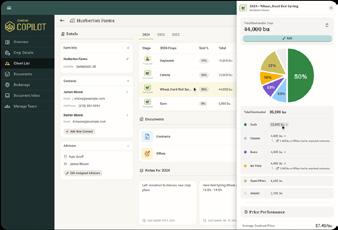









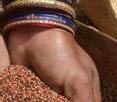















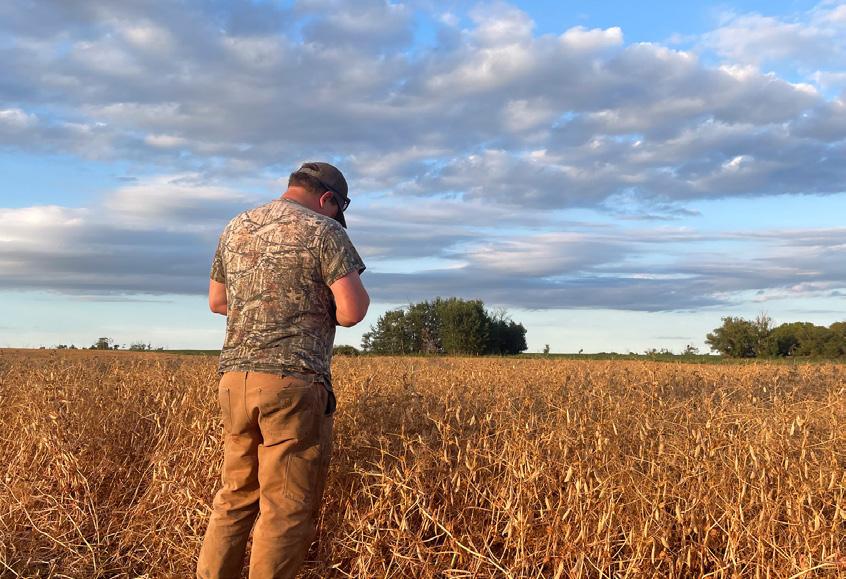



UFA first flew the maple leaf in 1957 — nearly a decade before Canada. Our roots in this country run as deep as our dedication to its farmers and ranchers. 116 years later, we’re still proud as ever to be Canadian.

Enter reports anytime, anywhere with the CLTS MOBO app Submit data in real time or save reports for later, offering flexibility whether you're in the field or at your desk. The MOBO app makes traceability reporting timely, accurate and hassle free
WE’RE HERE TO HELP




Your education is more powerful when it’s real. At Lakeland College, you learn through real-world scenarios, like managing our Student-Managed Farm – Powered by New Holland, running our student-led Animal Health Clinic, or planning and hosting events such as Farm 4.0: The Future of Agriculture or Band in the Sand.
The future doesn’t wait, so why should you? Learn more at lakelandcollege.ca/ag.






































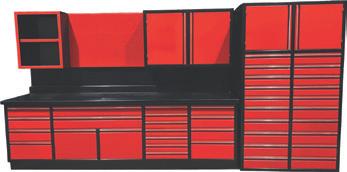

By Doug Ferguson

Research at Olds College of Agriculture & Technology is helping to transform farming by laying the groundwork for innovations that might have seemed like science fiction just a few years ago.
It includes what has been described as an artificial intelligence stethoscope that could diagnose medical conditions earlier and more accurately in everything from livestock to people. The imPulse Una device is being developed by Level 42 AI, Inc., parent company of Vibrome, Canada.
“Pressed against the body, through fur and dirt, the Una helps us ‘hear’ what the human ear cannot hear, ‘feel’ what is imperceptible and ‘see’ the invisible,” says CEO Shasha Jumbe.
Its sensors offer a non-invasive way to capture audible sounds and inaudible vibrations within living bodies, decoding hidden patterns in people, sheep, cattle and even colonies of bees, he adds.
The college’s Technology Access Centre for Livestock Production (TACLP) was chosen by the Silicon Valley startup company to test the effectiveness of the imPulse Una on sheep. “Our algorithms need domain expertise, input and guidance to be interpretable and generalizable,” says Jumbe. “That means combining clinical insights, veterinary science and on-the-ground feedback from farmers. Olds College brings all of that to the table.”
Researchers looked at Haemonchus contortus, which is commonly known as the barber’s pole worm. The blood-feeding parasite is a major threat to sheep flock health and profitability,
“Pressed against the body, through fur and dirt, the Una helps us ‘hear’ what the human ear cannot hear, ‘feel’ what is imperceptible and ‘see’ the invisible.”
- Shasha Jumbe
with traditional diagnostics lagging behind the disease.
Early trials of the imPulse Una showed it is able to distinguish between infected and non-infected ewes before any noticeable symptoms, says Dr. Yaogeng Lei, research scientist at TACLP.
It could allow sheep farmers to treat only infected animals, reducing costs and slowing the spread of drug resistance in the worms from broad use of ivermectin. However, Lei cautions more research is needed in real-world, multiparasite settings before there is widespread use on farms.
Researchers are also investigating the device’s capability for early pregnancy detection in sheep. “If an ewe is carrying multiple fetuses, her nutritional needs would be higher than those with a single fetus,” says Lei. “Without enough feed, she risks weak offspring. Early pregnancy detection would
also help with breeding plans, allowing open ewes to be rebred sooner.”
Jumbe says pregnancy data obtained from sheep could also be a game-changer for human health. “What we learn in livestock is helping to fine-tune algorithms that detect life-threatening conditions like preeclampsia and gestational diabetes earlier and more accurately in pregnant women.”
These conditions are leading causes of maternal and infant death, especially in India, Africa and among women globally who are Black, Indigenous and People of Colour (BIPOC), he says. “By tuning into the body’s silent signals across species, we are training our artificial intelligence to listen for danger before it strikes.”
The adoption of technology on the farm has been fundamental to the development of modern society, says Todd Ormann, vice president of external relationships and research at Olds College. “This technological advancement in farming is accelerating at an unprecedented rate. What might have seemed like futuristic concepts a decade ago are now becoming a reality within just a few growing seasons, particularly with the integration of data and artificial intelligence.”
Research at Olds College includes data from some of the most studied fields on Earth, including data from the International Space Station. The $3.4-million HyperLayer project examined fields at the college’s Smart Farm, which is a high-tech, living laboratory for crop, livestock and agricultural technology research totalling about 3,000 acres.
The project’s team studied multiple fields in unprecedented detail involving many layers or types of data, including the interaction between crops, soil and microclimates, notes Dr. Felippe Karp, who is an instructor and researcher at the college’s Werklund School of Agriculture Technology.
The team built a digital platform to not only share about four terabytes of data with partners but also to create a computer model that can make predictions for further research, he says. “Right now, I can go into that platform, access what I need to generate my prediction and click on a button.”
Although the platform was trained using data from fields containing black soil at the Smart Farm in central Alberta, it has made realistic predictions about farmland in Saskatchewan operated by Olds College. The fields near Craik, north of Moose Jaw, contain different soil with less organic matter and a drier climate, says Karp.
If similar or even partial sets of data as that of the HyperLayer project were collected from all the regions in Canada, researchers could use them to build an extremely
powerful model for the entire country that could help the nation’s farmers, he adds.
He emphasizes the HyperLayer project represents only the initial phase of what could potentially be exciting new technologies for agriculture. However, his vision is that efforts like these by researchers around the world will lead in a few years to something like an artificial intelligence assistant for farmers.
According to Karp, producers could have human-like conversations with the assistant via their smartphones to manage data about their farms – and even work as a team on equipment such as seeders to adjust seeding rates and create prescription maps – boosting their profits by making more informed decisions.
“Every time I talk to farmers, the agriculture industry and agronomists, the message that comes across is, ‘I don’t have time. I don’t have time to organize and go over all the data that I have. I need something that can help me.’”
Karp says artificial intelligence is “just a tool” that works best in collaboration with human experts who can provide guidance, context and insights. He emphasizes farmers and agronomists will still have the final say as they work with the artificial intelligence assistant.
It will ease their workload by acting like an operational manager that’s immediately available any time it’s needed. “That’s how I see Olds College helping increase the capabilities of artificial intelligence to assist farmers through the data set that we’ve been building as part of the HyperLayer project,” he says.
As technology continues its relentless integration into our food supply, applied research – such as the work at Olds College – is becoming increasingly crucial, says Ormann. “It’s essential that new technology is fully validated and tested before being used on farms and ranches. This ensures producers get solutions that provide real value and a strong return on investment, benefiting both agriculture and society.”
Learn more about Research at Olds College of Agriculture & Technology


‘Symphonies’ of Living Bodies Could Help Diagnose Diseases Demonstration of the HyperLayer Project

Ag producers are the backbone of Alberta’s food production. ATB has stood with crop producers since 1938—helping them survive hard times and thrive in the good times. Let’s work together to see how ATB can support your operation for generations to come. Let our crop financing expertise guide you as you grow your farm for the next generation.




